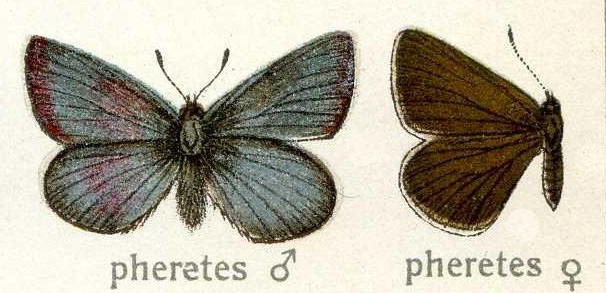- Albulina pheretes
image_width = 240px
image_caption = "Albulina pheretes" Male upperside on left.Female upperside right.
regnum =Animal ia
phylum =Arthropod a
classis =Insect a
ordo =Lepidoptera
superfamilia =Papilionoidea
familia =Lycaenidae
genus = "Albulina "
species = "A. pheretes"
binomial = "Albulina pheretes"
binomial_authority = (Hübner, 1805)The Mountain Blue ("Polyommatus pheretes") [http://internt.nhm.ac.uk/jdsml/research-curation/projects/lepindex/detail.dsml?TaxonNo=206138.0&UserID=&UserName=&&listPageURL=list%2edsml%3fSCIENTIFIC%5fNAME%5fon%5fcardqtype%3dstarts%2bwith%26sort%3dSCIENTIFIC%255fNAME%255fon%255fcard%26SCIENTIFIC%5fNAME%5fon%5fcard%3dpheretes%26recLimit%3d30&searchPageURL=index%2edsml%3fsort%3dSCIENTIFIC%255fNAME%255fon%255fcard%26SCIENTIFIC%5fNAME%5fon%5fcardqtype%3dstarts%2bwith%26SCIENTIFIC%5fNAME%5fon%5fcard%3dpheretes%26recLimit%3d30 Card for "pheretes" in LepIndex. Accessed 14 October 2006.] ] is a small
butterfly found in theHimalayas Evans,W.H.(1932) The Identification of Indian Butterflies, ser no H22.14, pp 228] that belongs to the Lycaenids or Blues family.Description
:"See glossary for terms used"
Race "lehana", Moore
Male upperside is purplish blue with dark blue at the bases of the wings. Fore and hind wings with somewhat obscure, slender, black, anticiliary lines, followed by very full, snow-white cilia. The underside is grey, pale plumbeous brown on the discs of the wings, the bases of both fore and hind wings irrorated with bluish-green scales. Fore wing has a narrow transverse black lunule on the discocellulars and a transverse curved discal series of five white spots, each spot centred with black. Hind wing has a streak in the cell, a spot above it near the costa and a discal series of five spots, of which the posterior four are in a very oblique line directed outwards, and the upper or fifth is much larger, placed much further inwards above the apex of the cell. In the type and a few others the discal spots are seven or eight in number, and smaller than in the majority of specimens. Antennae dark brown, the shafts as usual ringed with white; head, thorax and abdomen clothed with bluish hairs; the palpi fringed with black hairs, thorax and abdomen white.
The female is similar to the male, but on the upperside the ground-colour is rich brown, the bases of the wings only blue. Underside : ground-colour and markings as in the male. Antennae, head, thorax and abdomen similar to those of the male but the latter three brown, not clothed with bluish hairs.Bingham, C. T. 1907. Fauna of British India. Butterflies. Volume 2]
Has a wing expanse of 28-30 mm.Found in the western Himalayas (Ladakh, Kashmir) at elevations from 8000 to 12,000 feet.
Race "asiatica", Elwes
Fore wing much more pointed at the apex, termen straighter, wing altogether proportionately shorter than in race "lehana". Other differences are as follows :— The underside of te male has a rich metallic dark blue, quite different from the purplish blue of the parent form or of race "lehana". Underside has the ground-colour and markings similar to those of "lehana", but on the fore wing the discal spots are generally entirely absent or reduced to one or two, while the hind wing is irrorated with metallic greenish-blue scales for two-thirds of its length from base. Otherwise similar.
Female has the upperside much as in race "lehana" but the underside with the obsolescence of the markings on the fore wing and the irroration of metallic greenish-blue scales on the hind wing as in its own male.Has a wing expanse of 25-27 mm. Found in Sikkim in the Chumbi valley, from an elevation of 12,000 to 15,000 feet.
Taxonomy
The butterfly was earlier known as "
Polyommatus pheretes " Moore. The butterfly taxonomy is under revision.Marrku Savela's Website on Lepidoptera [http://www.funet.fi/pub/sci/bio/life/insecta/lepidoptera/ditrysia/papilionoidea/lycaenidae/polyommatinae/albulina/index.html| Page on "Faunis" genus.] ]Cited references
ee also
*
Lycaenidae
*List of butterflies of India (Lycaenidae) References
* Beccaloni, G. W., Scoble, M. J., Robinson, G. S. & Pitkin, B. (Editors). 2003. The Global Lepidoptera Names Index (LepIndex). World Wide Web electronic publication. http://www.nhm.ac.uk/entomology/lepindex [accessed 14 October 2006] .
* Evans, W.H. (1932) The Identification of Indian Butterflies. (2nd Ed), Bombay Natural History Society, Mumbai, India
Wikimedia Foundation. 2010.

